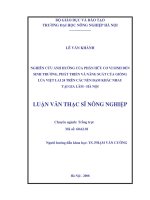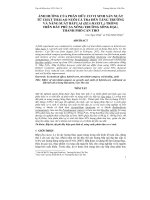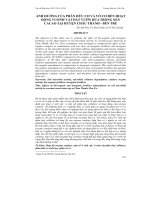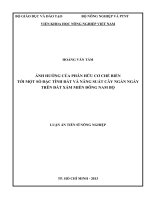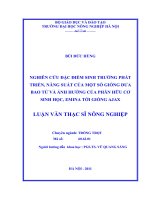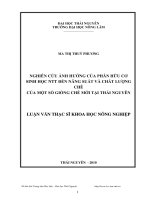Ảnh hưởng của phân hữu cơ chế biến tới một số đặc tính đất và năng suất cây ngắn ngày trên đất xám miền Đông Nam Bộ
Bạn đang xem bản rút gọn của tài liệu. Xem và tải ngay bản đầy đủ của tài liệu tại đây (1.57 MB, 167 trang )
T NAM
- 2013
T NAM
Chuyên ngành :
: 62 62 01 03
2.
2013
1. GS. TS. Võ Minh Kha
i
Hoà
ii
con nông dân.
GS. TS Võ Minh Kha, nguyên
n
S.
Tôi xin trân Ban
Tôi xin trân
H
PGS. TS S.
S.
iii
Tôi xi Ban
xã Tân Phú
iv
BVTV
C-AF Carbon-Acid fulvic
C-AH Carbon-Acid humix
AH Acid Humix
C-Labile
C-OM Carbon-
CEC
HCCB
HCVS
HCK
HCSH
H
2
Ohh
HC
NSU
OM
SSP Single super phosphate
TB Trung bình
TP Thermo phosphate
VSV
v
5
42
42
trong 43
khoáng dùng
44
-NH
4
+
58
. 60
62
-NH
4
+
64
65
66
70
71
(C-OM) 73
74
vi
75
hàm l
và C-AH/C- 76
(Cmol
+
/kg). 77
78
i l 80
82
83
g thân lá ngô (% P) 84
85
thân lá ngô (% K) 86
87
-3) 89
xám - 7) 90
nh h
xám
90
vii
-2011) 93
Tây Ninh (2010-2011) 94
-2011) 96
cho 99
sung
101
104
106
108
111
112
viii
23
24
Hình 3.1 T-NH
4
+
l 59
Hình 3.2. T
61
Hình 3.3. T
phân c bón vào. 63
Hình 3.4 T-NH
4
+
và
pH
(KCl)
65
Hình 3.5 Tng quan
(C- 67
96
98
. 102
vi sinh bón vào và
107
khoáng bón vào và
109
113
ix
i
N ii
iv
v
viii
ix
xv
ABSTRACT xix
1
1
3
3
3
3
CH 5
5
5
5
5
6
6
6
7
7
8
1.1.3.1 S l 8
9
x
10
1.2 Thành p 14
14
17
20
23
1.3.1 Quá trình khoáng hóa (Mineralization Process) 23
1.3.2 Quá trình mùn hóa (Humusification process) 24
25
1.4.1 S l 25
trong n 27
29
nhà nông) 29
30
31
32
34
37
37
37
38
38
38
39
39
CH PH 41
xi
41
41
41
41
41
44
45
2.5 Ph 45
2.5.1 Ph 45
2.5.1.1 Ph 45
45
2.5.1.3 Ph
45
2.5.1.4 Ph
46
2.5.2 Ph 47
2.5.3 Phng pháp nghiên c 48
48
48
2.5.3.3 Ph 49
50
2.5.4 Ph 50
2.5.4.1 Phân tích phân bón 50
51
52
2.5.4.4 Ph 55
2.6 Ph 56
CH- 57
xii
57
-NH
4
+
58
59
61
63
N-NH
4
+
63
lân (P) 65
3
kali (K) 66
69
69
71
71
72
77
78
79
79
l 81
81
xiii
82
84
84
3 85
ng l 85
86
86
88
88
n
92
92
vi sinh và
94
khoáng và
. 96
3.4.2.4 Tính toán l
98
100
3.4.3
phân khoáng trên cây ngô 103
xiv
103
vi sinh và
Tây Ninh 105
khoáng và
Tây Ninh 108
3.4.3.4 Tính toán l
110
111
115
115
117
118
119
119
128
133
xv
Lun án th hin ni dung và kt qu
và
u kin t nhiên và kinh t xã hi thun
li vào bc nht so vi các vùng kinh t khác trong c c v phát trin nông
nghip toàn din vi nhng sn phm hàng hóa có giá tr. Dit nông nghip
n có gn 1,8 trit xám (Acrisols) chim trên 30%,
tr thành mt sn xut nông nghip ch yu ca vùng.
V vai trò ht sc quan trng ca phân hi v phì nhiêu ct
ng cây trc bit xám không phi bàn cãi.
có ngun cung cp ht n hin nay, thì vic
tn dng ngun ph ph phm trong trng tr. Vi s phát
trin ca nn nông nghip c nhà n này, thì vic nghiên cu s dng
nhng loi phân hc ch bin công nghip thay th chúng là mt mt
nhu cu tt yu. Các sn phm phân h bin hin nay rng trên th
c nghiên cu nhiu v nng c phì nhiêu
ct cây trng dng chúng. Chính vì vy,
vic nghiên cu phân hn thng, s dng hp
lý các loi phân h bin cùng v ci thi phì, nâng cao
hiu qu sn xut nông nghip clà ni dung chính c tài lun
án.
Kt qu nghiên cu kh ng (N, P, K) c t xám
thy p
xvi
-NH
4
+
2
= 60; CV = 7,35%) này
4,92
2
k
2
0,4656 (n=60, CV=7,48; Prob.= 0,004), và
:
-NH
4
+
(KCl)
>pH
(H2O)
>C-OM>CEC>C-AH>C-AF.
(H2O, KCl)
, CEC và C-
-OM > CEC >
pH
(KCl)
> pH
(H2O)
-
112,5x -
2
= 0,4107 (p <0,0001, n = 60).
C-
(C-
0,37- 0,54 Cmol
+
c bón nói trên,
xvii
, các công
u 62,81 %), t
71,05%); t
0,040 51,45%).
Bón
lá sau HCK Growmore (5-5-
HCK Humix (6-2-
.
c,
Omix (1-3-1), 0,94
34,31%. Tuy nhiên, 1500
HCK Omix (3-3-3),
29,33%.
1800 kg/ha/
Trên cây ngô, s
.
xviii
11,31HCVS Omix(1-3-1)
HCK Omix(3-3-3).
: 750-2800 kg/ha HCVS Omix(1-3-1)
750HCK Omix(3-3-3).
xix
ABSTRACT
The thesis presents the contents and results of research, viewing the impact
of certain types of processed-organic fertilizers to some physical, chemical, and
biological properties of the Acrisol soil on the South-East region, and influence of
them to the yields of some short-term crops (vegetables, peanuts, maize), as well as
the ability to replace a part of mineral fertilizer with processed-organic fertilizers.
The South-east is a region, with the advantages in natural and socio-
economic conditions in comparison to most other economic regions in the country,
in terms of comprehensive agricultural development, with valuable goods. Recently,
there is nearly 1.8 millions ha of agriculture land in the region, of which the grey
soil group (Acrisols) make up over 30%, becoming one of the two mature groups of
land, predominating agricultural production of the region.
About the critical role of oganic matters for soil fertility and crop nutrition,
especially on the grey soil, has been no longer dispute. But to get enough organic
fertilizers for the current period, the taking most advantage of wastes, by-products
of crop and livestock production is not sufficient. With the development of
agricultural sector in the country at this new stage, the study of the use of processed
- organic fertilizers to replace them is an inevitable demand. Processed-organic
fertilizer products, recently, is very diverse in the market and has not been much
studied on their effects to soil fertility and crop productivity. Thus, the study,
evaluation of the ability to substitute traditional manure, fair use of oganic-
processed fertilizers in co-operating with mineral fertilizers to improve the fertility
of the soil and productivity of crops on this grey soil, is the main contents of the
thesis.
Research results of the nutrition (N, P, K) absorbing ability of gray soil
showed that processed-organic fertilizers have significant ability in improving
absorption of nutrients (N, P, K) of gray soil, thus enhancing buffering competence
for keeping and providing nutrition for the plant. This is one of the important bases
xx
for the recommending application of combining organic and inorganic fertilizers,
enhancing the efficency of fertilizers for crops on grey soil. With the doses of 2,56 -
10,24 g/kg of soil, processed-organic fertilizer has increased the nutrition absorbing
ability of soil as: increased the absorption of N-NH
4
+
from 8,2 to 20,7% in the
comparison with non-organic fertilizer, at a significant correlation (R
2
= 0.4268; p<
0.0001; n = 60; CV= 7,35%), with single variable regression equation y = 1, 3387x
+ 70.804; increased phosphate absorbing ability from 4.92-15.54% compared with
non-organic, with linear equation y = 1,1477x + 77,544, and correlation coefficient
R
2
=0.3402 (n=60, Prob=0.002 and CV = 7.64%); increased the ability of potassium
absorption from 5.57-21.86% compared with non organic, with correlation
coefficient R
2
= 0,4656 (n=60, CV=7.48; Prob=0.004), and linear regression
equation y = 2, 5833x + 120.35.
The nutrition absorbing ability of the grey soil, with organic fertilizer
addition, depending not only on the amount of added organic fertilizer but also quite
strong with some properties of soil chemistry such as, the degree of correlation
between the ability of absorbing N-NH4
+
and some soil properties, in order from
high to low as pH
(KCl)
> pH
(H2O)
> C-OM > CEC > C-AH > C-AF; the phosphate
absorbing ability has a linear relationship with the pH
(H2O, KCl)
, CEC and C-OM at
the probability of <0,01; the ability of potassium absorption of grey soil, added
organic fertilizer, has correlation with soil properties, in order from high to low as
C-OM > CEC > pH
(KCl)
> pH
(H2O)
. The content of organic matter in soil (C-OM)
significant impacts to the K absorption of the soil, with a linear regression equation
y = 112, 5 x -3.3581, R
2
= 0.4107 (p < 0.0001, n = 60)
Research results also showed that the use of processed-organic fertilizer,
with the doses as above, has improved some of fertility properties of soil, including
moisture capacity and the amount of effective water in the soil; increased the
number of organic carbon (C-OM), quality of organic matter (C-AH) in the soil;
improved absorption capacity (CEC) from 0,27-0,54 Cmol
+
/kg (equivalent to the
2.53-8.53% compared to non-organic). With the applied doses of processed-organic
xxi
fertilizer as above, the density of nitrogen-fixing microorganisms, phosphorus and
cellulose decomposition have significant increased according to the amount of
processed-organic fertilizer. However, heavy doses of this kind of fertilizers were
tedencing in temporarily decrease of pH values, thus causing necessary to
supplement the soil with phosphate fertilizers or lime.
Fertilize the grey soil with processed-organic fertilizers has increased
nutritional (N,P,K) providing ability of it, improving the effect of mineral fertilizers,
especially nitrogen fertilizer. In commparison with mineral fertilizers, processed-
organic fertilizers have increased total N absorption from 0,053-0,224g/pot, (in
equivalent with 19,13-62,81%); increased total P absorption from 0,007 - 0,027g
/pot (equivalently 18,4271,05%); increased total K absorption from 0,040- 0,142 g
/pot (also 14,49-51,45%)
Applying the processed-organic fertilizers continuously for many years, with
a reasonable amount, can replace the entire amount of mineral fertilizer for
vegetables, that still remaining higher yield than those of mineral fertilizers. On the
other hand, processed-organic fertilizers can completely replace the amount of
traditional manure that farmers often used, with the quantity of just 1/3 of manure.
This is one of the scientific bases for recommendation in safe vegetable production,
folowing organic cultivation. On leafy vegetables, after 7 crops applied with
mineral-organic fertilizer Growmore (5-5-5), the yield increased 9.22 tons/ha,
equivalent to 50.66%; with mineral-organic fertilizer Humix (6-2-2), the yield of
vegetable rose 8.34 tons/ha, equivalent to 45.82% compared to mineral fertilizers.
On peanuts, with doses of 500-2000 kg/ha/crop of processed-organic
fertilizers, in addition of mineral fertilizers (N, P, K) to the same level of nutrition
as mineral fertilizer control, has significantly increased agronomic effectiveness.
With applied bio-organic fertilizer, the average 2 crop yields of peanut increased by
0.43 - 0.94 tons/ha/crop, equivalent to 15,69 34,31%. However, in the amount of
500-1500 kg/ha/crop it gave the highest economic efficiency. With mineral-organic
fertilizer, the yield of peanut increased 0,33 0,83 tons/ha/crop compared to control,
xxii
equivalent to 11,66-29,33%. The doses for highest economic efficiency of this
fertilizer is about 1000-1800kg/ha/crop.
On corn, the all doses of 750 - 3000 kg/ha/crop of processed-organic
fertilizers, with additional mineral fertilizers (N, P, K) to the same standard level of
mineral fertilizers, increased the yield of the crop. In comparison wih mineral
fertilizers, the yield of corn increased 0,62 1,92 tonnes/ha/crop (11,31-35,03%)
for bio-organic fertilizer, and from 0,50 1,65 tonnes/ha/crop (9,10-30,00%) for
mineral-organic fertilizer. The best doses of processed-organic fertilizer are 750-
2800 kg/ha/crop for bio-organic fertilizer, and 750-2200 kg/ha/crop for mineral-
organic fertilizer.
For conclusions, the prprocessed-organic fertilizers may completely replace
(for leafy vegetables) or partially (for peanuts, corn) mineral fertilizers (widely used
nowadays), with good productive and economical efficient for short-term crops on
South-Eastern grey soil.
1
1.
n ha [32],
[33
èo
m các t
Tây Ninng Nai, Bà Ra- H Chí Minh, có din tích t
u ha. Nm trong vùng kinh t trm phía Nam vi nhng
thun ln v khí hu thi tia hình bng phng, giao thông phát trin,
nguu kin sinh thái nông
nghip thun li bc nht trong c c. Vi dit nông nghip gn 1,8 triu
t xám (Acrisols) chim trên 30%, là mt
sn xut nông nghip ch yu ca vùng. a hình khá
bng phng tt c các t, vi nhn là tt dày, d
c, d i thô, nhng,
CEC thp nên d b ra trôi, xói mòn.
H thng canh tác nh hình vi nhiu cây
trt hiu qu kinh t ng dii tp trung,
thâm canh 2-3 v u các loi và mt s loi cây
công nghip khác. Thc t cho thyt cây trt xám
không chênh lch nhiu so vi tr
canh lc bit là chi phí phân bón. Mt khác, hiu lc s dng phân bón
t xám rt thp, vì vy xu th iu phân hóa h t
cao va ng xt, làm gim tính bn vng
trong sn xu ng b ô nhim, tu kin cho dch hi phát trin.

